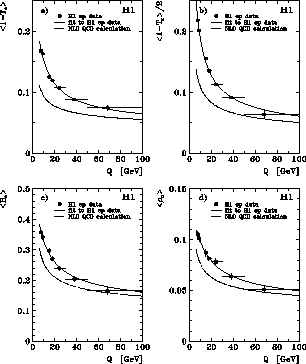A natural frame in which to study the dynamics of the hadronic final
state
in DIS is the Breit frame [22].
In this frame the exchanged
virtual boson is purely
space-like with 3-momentum ![]() , the incident quark
carries momentum Q/2 in the positive Z direction,
and the outgoing struck quark carries Q/2 in the negative
Z direction. A final state particle has a 4-momentum
pB in this frame,
and is assigned to the current region if pBZ is negative, and to the
target frame if pBZ is positive.
The advantage of this
frame lies in the maximal separation of the outgoing parton from
radiation associated with the incoming parton and the proton remnant,
thus providing the optimal environment for the study of the
fragmentation of the outgoing parton.
, the incident quark
carries momentum Q/2 in the positive Z direction,
and the outgoing struck quark carries Q/2 in the negative
Z direction. A final state particle has a 4-momentum
pB in this frame,
and is assigned to the current region if pBZ is negative, and to the
target frame if pBZ is positive.
The advantage of this
frame lies in the maximal separation of the outgoing parton from
radiation associated with the incoming parton and the proton remnant,
thus providing the optimal environment for the study of the
fragmentation of the outgoing parton.
Event shape variables have been investigated in e+e-
experiments and used to extract the strong coupling constant
![]() independent of any jet algorithm,
see eg ref. [23].
H1 have recently performed a similar analysis [24]
in deep inelastic scattering
in the current fragmentation region
of the Breit frame.
independent of any jet algorithm,
see eg ref. [23].
H1 have recently performed a similar analysis [24]
in deep inelastic scattering
in the current fragmentation region
of the Breit frame.
The event shape dependence on Q (or energy dependence)
can be due to the logarithmic change of the strong coupling constant
![]() , and/or
power corrections (hadronisation effects)
which are expected to behave like 1/Q.
Recent theoretical developments suggest that 1/Q corrections are not
necessarily related to hadronisation, but may instead be a universal
soft
gluon phenomenon associated with the behaviour of the running coupling
at
small momentum scales [25,26].
, and/or
power corrections (hadronisation effects)
which are expected to behave like 1/Q.
Recent theoretical developments suggest that 1/Q corrections are not
necessarily related to hadronisation, but may instead be a universal
soft
gluon phenomenon associated with the behaviour of the running coupling
at
small momentum scales [25,26].
H1 have analysed a number of
infrared safe (ie independent of the number of partons produced)
event shape variables.
Their definitions are given below,
where the sums extend over all hadrons h
(being a calorimetric cluster in the detector or a parton in the QCD
calculations)
with four-momentum
![]() The current hemisphere axis
The current hemisphere axis ![]() coincides with the virtual boson direction.
coincides with the virtual boson direction.
| <B>B> | (1) |
| <B>B> | (2) |
| <B>B> | (3) |
| <B>B> | (4) |
A common characteristic of the mean event shape values
![]() and
and ![]() is the fact that they exhibit a clear decrease with rising Q,
fig. 5.
This is due to fact
that the energy flow becomes more collimated along the event
shape axis as Q increases, a phenomenon also observed in e+e- annihilation experiments.
is the fact that they exhibit a clear decrease with rising Q,
fig. 5.
This is due to fact
that the energy flow becomes more collimated along the event
shape axis as Q increases, a phenomenon also observed in e+e- annihilation experiments.
 |
H1 showed by fitting to the data in fig. 5
all the event shape variables can be well described by just the
first order power
corrections ![]() without the need for any higher order
corrections.
The second order perturbative QCD parton predictions are also shown and
their discrepancies with the data show that
the power corrections are substantial
at low
values of Q, but become less important with increasing energy.
without the need for any higher order
corrections.
The second order perturbative QCD parton predictions are also shown and
their discrepancies with the data show that
the power corrections are substantial
at low
values of Q, but become less important with increasing energy.
The analysis of the event shapes give results consistent with each other
for ![]() the power correction parameter
thus supporting the
prediction of universality [25],
and also gives consistent values of
the power correction parameter
thus supporting the
prediction of universality [25],
and also gives consistent values of ![]() The results of the fit are
The results of the fit are
![]() for the power correction parameter and
for the power correction parameter and
![]() for the strong coupling constant in the
for the strong coupling constant in the ![]() scheme.
These values are compatible with those extracted by e+e-
experiments [27]
scheme.
These values are compatible with those extracted by e+e-
experiments [27]
latex2html conversion by www person on 1997-10-22